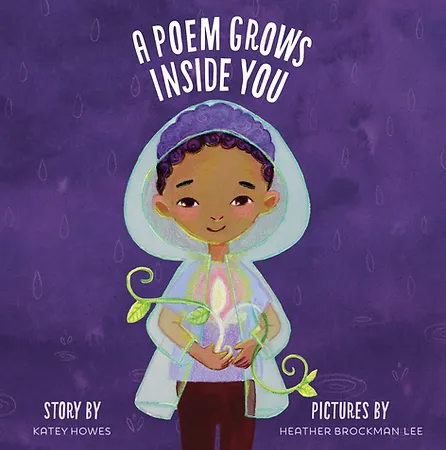
Happy holidays, poets and poetry fans! I’m excited to tell you about a beautiful book today, one you’ll want to share with young readers and writers in the new year.
A Poem Grows Inside You by Katey Howes, illustrated by Heather Brockman Lee, is a picture book about the creative process. How do ideas, experiences, or observations grow into poems? Like seeds, poems-to-be must be nurtured.
I have one copy of A Poem Grows Inside You to give away. If you live in the U.S. and would like to be entered into a drawing for the book, please “raise your hand” in the comments. And be sure to read all the way to the end of this post for some upcoming book news from me!
Here is a description of the story from Goodreads:
We all hold the seed of something wonderful inside us, just waiting for the right moment to bloom. In A Poem Grows Inside You, the seed of an idea waits for the rhythm of the rainfall to awaken it, then takes root and begins to grow. At once a celebration of the deep connection creatives have with their art and an acknowledgement of the courage it takes to let it into the sun, this beautifully illustrated picture book encourages readers to nurture their talents and boldly share them with the world.
Katey Howes is here to answer 5 Questions about her picture book!
1. I love the body-science words peppered into the text: platelet, hydration, tendons. For me, this speaks to the way poetry is grounded in our physical experience. Why did you want to include this vocabulary in your book about nurturing an idea from inspiration to poem?
Katey: It’s great to know that you enjoy those more biological words in the text! I originally trained and worked as a physical therapist, and I love biology and neuroscience. I often think about how deeply intertwined our anatomy and physiology can be with our thoughts and emotions. Once I began imagining an idea lying dormant inside my body – any body – I began to picture it very literally and wanted to communicate that to readers, especially to kids who are as scientifically-minded as I was as a child.
2. At what point in the drafting process did you add the layer of springtime as a metaphor for growing a poem? How do the illustrations support this layer of your story? (My favorite spread is the one where we are looking up through water at the main character.)
I love that spread, too! Heather has been amazing at bringing this story to life. Her depictions of roots, tiny leaves, and buds gradually growing and spreading with so much color and motion just thrill me. I could talk about them all day – but will try to focus on your original question about springtime.
When I talk with kids at school visits about “being a maker,” we discuss saving ideas in a notebook or special place. We talk about how artists, writers, inventors – all kinds of creators – may need to hold on to ideas until they have the right resources in place. Those resources might be skills, materials, teammates, time – so many things. It became clear to me very quickly when I started expanding on the “waiting for the right resources” parallel between poems and seeds that spring brought many of the things a seed needs to move from dormancy into active growth. Weaving those details into the poem just made sense!
3. There is a moment when the main character wants to hide his idea, his poem-to-be, out of fear that others will question or misunderstand it. That makes sense to me! The concept for a book or poem is perfect – until you put it down on paper. YA author Maggie Stiefvater says that writing is an act of constant negotiation with that perfect book or poem in our heads. Why was it important to you to include this concept in a book for young readers?
It’s honestly a relief to know that many other people feel this way. I am often so frightened to put my creative work out where others can see it, even though I know that it is meant to reach beyond me.
From my work with children and adults in a variety of settings – everything from STEM camps to writing clubs – I recognize that too many of us have been encouraged or expected to strive for perfection from a very young age. We’ve been asked to make our art project look just like the example, our essay to fit the template, our math solution match the one in the back of the book, our Lego creation to be built exactly the way the instruction manual shows it.
My debut book, Grandmother Thorn, was born out of my realization that some of the sweetest things in life come to us when we let go of the need for control. Sharing that book with kids only strengthened my understanding of how much young kids feel this pressure to demonstrate control and to “be right.” I saw that some of that pressure comes from external sources, and some we place on ourselves.
Many of the books I’ve written since having those conversations – including POEM – have centered on the value and joy of making mistakes, letting go of control, being imperfect, and finding ways to overcome both the internal and external pressure to hide or be ashamed of creations that don’t match up with the “ideal.”
4. Speaking of perfection: Rhyming picture books are held to a high standard. The rhyme has to be unforced. The scansion must flow naturally when read aloud. What was it like working with your agent or editor on these poetic elements?
I tend to run my meter and rhyme through a tough vetting process before sending it to my agent. I make spreadsheets with columns highlighted to show where the emphasis should fall, then fill them in with one syllable per box, flag the places things don’t line up properly, and dig in to corrections! I also ask people (my kids, my critique partners, etc.) to read them aloud to themselves, and to me, so we can flag areas where the flow fails or variation in pronunciation throws things off. With that done ahead of time, Essie, my agent, gets to focus more on the heart, pacing, and storytelling than on the technical details – and that works really well for the two of us in partnership.
Once this manuscript was acquired at The Innovation Press, two editors (Asia and Jessica) dug in as well and gave me feedback and suggestions – though few specifically on meter or rhyme. Together we expanded the original text a bit, adding extra stanzas and layers to the story and being sure those flowed well with the existing structure.
5. Please talk about these lines and what they represent for you: “You let the whole world see / this poem you’ve been growing.”
For me, at this moment in my life, these lines are everything. I’ve always written – poems, lyrics, stories, essays – but for most of my life I’ve kept them secret. I’ve shared other parts of me, but hidden the writer.
Putting my words, my dreams, my imaginings out in the great big world for anyone to read has been terrifying and enlightening and freeing. It’s not just a poem I’ve been growing. It’s a mindset. A point of view. A career. An identity. And I recognize there is a possibility someone will think what I’ve been growing is “a weed.” Heck, I KNOW there are people who question why I’ve nurtured and grown it. And all I can say is, that is a pity for them, because there is such natural, nurturing, pervasive joy in seeing how and where it will bloom next.

Katey Howes is a haphazard gardener, a darn good rhymer, and a fun mother. She’s also the award-winning author of Rissy No Kissies, Be a Maker, and a growing assortment of other books. You can find Katey under a big tree on a small mountain in Eastern Pennsylvania with a bowl of popcorn, a notebook full of ideas, and a rescue pup named Samwise. Or find her on Twitter @kateywrites, on IG @kidlitlove, and at www.kateyhowes.com.
Still here, Reader?! Thank you for sticking around for my own bit of book news.
My 2023 poetry collection is available for pre-order. Welcome to Monsterville, with illustrations by Michael Rothenberg, is currently Amazon’s #1 new release in children’s humorous poetry! Did you know pre-orders can make a big difference in the life of a book, especially when it’s published by a small, indie press like Welcome to Monsterville‘s Apprentice House. I recommend ordering through Bookshop.org, which donates funds to independent bookstores.
Stay tuned for cover reveal news next week!






This looks lovely! I’ll look for it at our library. I think some 2nd grade friends would enjoy it.
Thanks for stopping by, Susan. This book would be a great way to get kids talking about the creative process.
Looking forward to reading this book! Katey is a master storyteller. I will enthusiastically raise my hand to win a copy. Thank you, Laura. And congratulations on Welcome to Monsterville!
Thanks, Rose. You’re going to love this one.
I LOVE A POEM GROWS INSIDE YOU! I was blessed to hear Katey read it on a zoom call we had with a group of poets and I immediately ordered a copy for my daughter-in-law for Christmas! How wonderful to read more of Katey’s thoughts that inspired the story!
And congratulations on Welcome to Monsterville! I look forward to reading that soon, too!
Happy New Year, Laura!
You got to hear Katey read her book! That must have been a delight. Thanks for the good wishes, Patricia.
I’ve seen this book on social media several times, but I learned lots of new things in this interview–thanks, Laura and Katey! I’m intrigued by the inclusion of the biological/anatomical vocab, and I’m so there for the idea of imperfection. So. There. Raising my hand. And congrats on Monsterville, too! Happy New Year to both of you!
Thanks, Laura. Katey doesn’t shy away from complex vocabulary. There are just enough of them here to tempt a would-be wordsmith or lexiphile.
Thanks for sharing this great intro, Laura. Can’t wait to read the book!
Thanks, Liz! I love the way Katey’s book is going to get readers thinking about their own creative processes.
Katey is a wonder, and this book works for me on so many levels. Everyone needs a copy! And YAY for Monsterville, Laura! That’s such great news. Congratulations! xo
Thanks, Irene! I agree — everyone needs a copy for inspiration!
Many writers can relate to Katey’s comments about creativity. Great interview and I’d love to read “A Poem Grows Inside You.” Children need to understand that mistakes actually should be made, that they are inevitable in the creative process, not a bad thing.
Absolutely, Janice. I’m reading a lot about rethinking the traditional writing workshop model. Process over perfection!
🙋♀️
Okay! Putting you in the drawing, Kim.
Laura, you ask such good questions! Thank you for recommending this book, which I will definitely be on the lookout for. As a late bloomer, I appreciate the emphasis on waiting until the right resources are in place and letting go of control. And congratulations on your new book!
Thanks JoAnn! I like how Katey connected the genesis of this book with her work with kids as makers.
This book by Katey sounds wonderful, Laura. Thanks for sharing more of Katey’s thoughts about it and her ideas about writing it and others. My library has it so I’ll see it soon!
I’ll definitely be taking it with me into school poetry workshops.
Laura, this is a fabulous interview. The questions were deep and the responses were filled with much information. The concept of a poem growing inside you would charm many children and give them the encouragement to find the poem and let it blossom. I can see that this book will be a keeper. Thank you for providing a giveaway. Happy New Year.
Thanks Carol! It is certainly an encouraging book.
This is sincerely one of the best “process” interviews I’ve read. I think all of us need to think about letting go of control and working towards excellence. I’d love to share it with kids…but I will also ask my local public library to get it.
Aw, thanks, Linda. Letting go of control is so important — engaging in creative play for its own sake. That’s actually how Welcome to Monsterville came about!
Annnnnnnd, WoW for Monsterville! Congratulations! I will pre-order.
Thanks, friend!
Thanks for the terrific conversation, Laura and Katey! (And no need to put me in the drawing as I had the pleasure to preview this wonderful book.)
Yay, Buffy! You’re welcome.
I’ve been a fan of Katey’s since BE A MAKER and it’s both fun and revealing to hear her at-length answers to your in-depth questions, Laura. I would love to add this book to my collection of “What Do Poets Do” books!
Thanks, Heidi. I’m putting your name in the hat!
I love A POEM GROWS INSIDE YOU and I’m planning to use it January with students for some poetry units. Thanks for this great interview. I’m also looking forward to reading your poetry collection, Laura!
Thanks, Marcie. I’m looking forward to sharing this book during my poetry residencies.
What a fascinating book, “A Poem Grows Inside You” sounds like, and marvelous questions and answers about it . Thank you both, Laura and Katie, I’m looking forward to reading it, along with your new book Laura, “Welcome to Monsterville,” Congrats!
Thanks, Michelle! It’s a beautiful book.
[…] This week, I read A Poem Grows Inside You, by Katey Howes and Heather Brockman Lee. It’s a lovely book that I won in the giveway from Laura Shovan. You can read Laura’s very cool writeup about this book here. […]